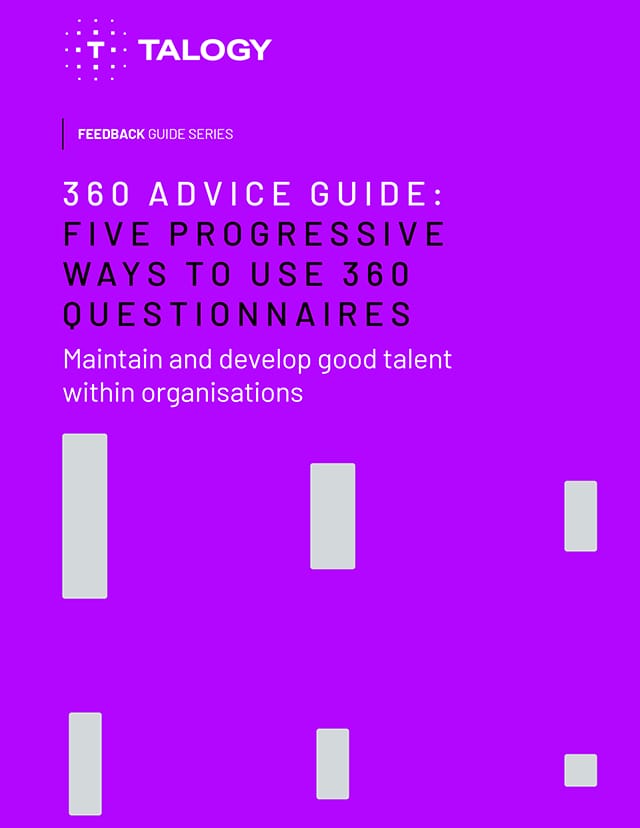Written by Paul Glatzhofer, Group Vice President Americas
360 feedback can be a powerful tool. However, delivering 360 review feedback can be challenging, and certain people are just naturally better at it than others. Over the years, I have trained hundreds of people on how to leverage this feedback to improve their team’s performance and foster growth. With the right practice and guidance, anyone can develop this skill and learn how to give 360 feedback effectively.
What is 360 feedback?
The 360 feedback review, or commonly referred to as ‘360 feedback’ for short, is a process where employees receive constructive feedback from multiple sources, including managers, peers, and direct reports. Using 360 feedback assessments, you can deliver targeted, actionable feedback that creates opportunities for powerful leadership and talent development.
Unlike traditional feedback methods, which typically involve just a supervisor’s input, 360 review feedback provides a well-rounded perspective on an individual’s strengths and areas for growth. By understanding what a 360 feedback review is and how to deliver its results effectively, you can ensure it has a meaningful impact for all participants. An added benefit is that this can then translate into a culture of continuous improvement and development within your organization.
How to deliver 360 feedback results
An obvious but often overlooked consideration of delivering 360 feedback is to come to the meeting prepared. We are all busy, but make sure to set aside time to review the results in advance. To make the 360 feedback review process as effective as possible, you want to come armed with a plan. You don’t want the first time that you’re analyzing the aggregated data to be right before, or even worse, during the discussion when you’re delivering the results.
Once you’ve completed this prep, you’re ready to employ the below tips for providing 360 feedback that can be can put into practice regardless of how many times you have or haven’t led this process.
Preparing for 360 feedback reviews:
Before you get started with the review process, make sure you’ve considered the following:
- Be clear about your intentions. Set the stage for the conversation by re-stating the goals of the 360 feedback review process while also reminding participants not to take any constructive feedback personally. Every single employee has room for improvement regardless of level, experience, or position.
- Remember that there are positives and negatives to each piece of feedback. For example, someone very high in attention to detail may struggle to think about the big picture and long-term implications. In that case, it’s best to work with them to provide suggestions on how to avoid getting lost in the details and adjust their short-term approach into a forward-thinking mindset. Make sure to point out that both approaches are important, but the ultimate goal is to achieve a balance between the two.
- Be objective, genuine, and non-judgmental. Your method of delivery is incredibly important when giving 360 review feedback. You never want recipients to walk away feeling discouraged because they will be less likely to make positive changes if they feel like they’ve been verbally ‘beat up.’ Be kind and direct with your words throughout this whole interaction.
During 360 feedback reviews:
Learn how to deliver 360 feedback results effectively using the following expert-recommended tips:
- Start the conversation with strengths. Most of us would prefer to hear about things that we do well over those where we have room for improvement. Beginning your 360 feedback reviews with positive news will serve as a reminder that the recipient is doing certain things well prior to receiving constructive feedback.
- Ask the person receiving 360 feedback for his or her own strengths and weaknesses. Soliciting this information upfront sets the tone for the rest of the meeting, as oftentimes employees are more aware of these attributes than they realize. These examples will help shape the rest of the discussion as feedback from their supervisor, peers, and subordinates will likely align and can be referred back to, solidifying where the recipient excels and where they can improve.
- Make it a two-way conversation and encourage questions. No one enjoys a meeting where they feel like they are being talked at, particularly when it comes to a personal critique. Creating a back-and-forth dialogue throughout the review process will make it feel less formal and put the recipient more at ease.
- Use behavioral examples and refer to job context – be specific. If you’re anything like me, examples can make a huge difference in terms of my follow-through. If I feel like I know how to put some of these suggestions into action, I’m much more likely to actively make a change. If I feel as if it’s more abstract, I will struggle to make any real progress. Break down the 360 feedback into digestible pieces that are easy to understand and leave the recipient with a good idea of what they can do to improve.
- Be constructive – focus on the future and next steps. When delivering 360 feedback results, you should remind recipients that this feedback isn’t meant to make them feel as if they’re on trial, but to simply address areas where improvements can be made. Phrase your feedback in a positive way, like “once you’ve mastered that skill, you can move on to working on this skill.” Using this approach makes improvements seem achievable while simultaneously encouraging recipients to break up their 360 feedback into smaller goals instead of trying to work on everything at once.
- Praise their strengths but don’t be afraid or hesitant to give feedback. While compliments are certainly warranted, you would be getting far less utility out of this exercise if you aren’t devoting some time to the identified weaknesses. We can’t forget that the use of ‘360’ within the name ‘360 feedback’ alone indicates a well-rounded view of the employee and their work style, both the good and the bad.
- Always end the 360 feedback review process on a positive note. An easy example would be: “You have some great strengths here – let’s focus on a few areas to help you be even more successful.” You want recipients to leave their reviews feeling good about what they are doing well within their job and empowered to improve in the areas where they may have gaps.
After 360 feedback reviews:
Once the review process has come to an end, make sure to keep this bonus tip in mind:
- Make 360 feedback stick. Leaving this meeting should not be the last time that these recommendations are discussed. Work this feedback into the employee’s individualized development plan and make it a point to touch base about their progress at least once a quarter.
Mastering the art of 360 feedback
Delivering 360 feedback effectively can transform the way teams grow and collaborate. By following these tips and mastering the review process, you’ll not only learn the best way to give feedback but also ensure the results are meaningful for all recipients. Remember, preparation, clear communication, and actionable insights are key to getting the most out of any 360 process.




